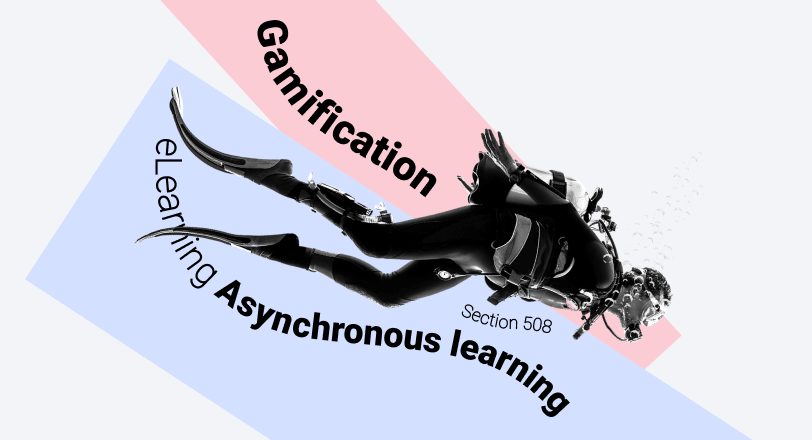How to Train New Employees for Success

You wouldn’t give a car key to a young man who has only attended one lesson at a driving school and let him go, right? The same with the employees who have just passed through a hiring process. Don’t push your new hires out of the nest too soon – let them feel comfortable in a new place and provide consistent training. New employee training is a crucial part of the onboarding process that will help your new team members move into their roles smoothly.
We asked eLearning experts to share their insights on how to train new staff effectively via eLearning and have assembled a guide that will help you organize the training process. Keep reading to dive into practical steps that you can start taking today. But first, let’s see why L&D professionals recommend training employees online.
Why Put New Employee Training Online?
In the times of yore, when employees stayed in one job for many years, companies could afford to have their new hires “learn on the job.” However, today, when the employee turnover is high – for example, in the USA, the annual average turnover rate is 44.3% – businesses can’t really afford to train each new hire individually. But they can help their newcomers integrate smoothly into the company via eLearning.
There are some indisputable benefits of training new employees online:
- Save time and money. You don’t need to create a new learning program or involve other employees to provide training for each new hire.
- Deliver informational consistency throughout the company, even if it is a large enterprise with many branches and departments. You can be sure everyone gets the same training.
- Train anytime, anywhere. New employees can access material 24/7 and even study the content and take quizzes on their mobile devices.
- Long-term retention of information. Many studies show that eLearning helps employees retain knowledge to a much greater degree than in traditional face-to-face settings.
Michael Sheyahshe, an eLearning developer and technologist with over two decades of experience, shared his expert opinion on why training new employees online is a good idea for businesses:

Michael Sheyahshe, Technologist at alterNative Media
- “Replicable and repeatable learning. Like other online and electronic delivery modes such as 3D models/media, immersive simulations, and VR, online training can be replicated and repeated, as needed, rather than investing time, resources, and possible additional funding into a real-world, in-person training.
- Prepares for today and the future. While I’ve worked remotely via telecommute for nearly a decade, many others are only now experiencing this professional modality, given the global pandemic [COVID-19 at this writing]. Online training can help prepare professionals for the rigors of working outside a physical office setting.
- Allows for possible modularity. Done well, online training can comprise various, smaller modular components or elements – think of a course with different external media, like videos, for example – which can potentially be removed, edited, updated, and/or expanded, as needed. This modularity can allow a longer shelf life for training content.”
Is online training what you were looking for? If so, read on to find out how to start training new employees via eLearning quickly and easily.
Step 1. Create a Unified New Employee Training Program
Training employees isn’t one size fits all. However, there’s one way that all the employees should proceed at the beginning of their career, and this is onboarding training. With the help of eLearning technologies, you can create a learning program once and then deliver it to all of your newcomers.
But what should be included in a new hire training program? Julia Somova, our Training and Development Manager at iSpring, shares her insights on what to cover to set employees up for long-term success.

Julia, Training and Development Manager at iSpring
“Of course, the program can vary depending on your company’s niche and policy. But the 3 elements that I list below are pretty universal to any organization.
- An introductory course on the company. It’s important to provide your new hires with company background information so they learn what it has already achieved and see the direction it is heading. Outline your company mission, values, and goals, overview the products/services provided, and explain who your customers and competitors are. You can also demonstrate the organizational structure of your company – every newcomer is interested to know on which level they are situated, what departments they are connected with, and where they can grow.
- A course on policies and general procedures. To give your new employees a deeper understanding of their work environment, deliver information regarding working hours, leave, sick time, pay, holiday policies, and dress code. It’s also important to cover topics like promotions, grades, expenses, reimbursement policies, and recognition awards.
- A compliance course. Providing information on compliance will help avoid confusion and many serious issues. Offer the training that will cover individual company regulations and all the security and legal issues like anti-harassment and discrimination, diversity, and workplace violence. Also, include health and safety training to ensure your newcomers are starting their careers safely and well informed.”
When creating a new employee training program, keep in mind that it should also contain assessments that will help you dentify whether your employees are getting the information they need in order to meet your expectations. Patti Shank, an expert in evidence-based workplace learning, considers that “training is inadequate if it only provides content.”
“We need to know if new employees are getting the right knowledge and understandings and if there are any misunderstandings and gaps that need to be addressed. We must also assure that participants can use the knowledge in the way they need, to be able to use it on the job.”
For example, you can include a compliance course in your onboarding program and, after your new hires complete it, ask them to take a test. This way, you can ensure that your newcomers know the compliance laws that are specific to your organization and protect both your employees and company from any costly legal problems.
If you’re going to train newly hired sales professionals or customer service agents, you can also include dialog simulations in your training program. They will help you master your new employees’ communication skills in a safe environment and avoid many mistakes right at the outset of their career.
Check out the following demo course to see a dialog simulation at work:
Step 2. Prepare All the Training Materials
Now that you’ve created a training program, it’s time to prepare the eLearning courses. Here you have three basic choices:
- Create courses in-house
- Outsource content creation to a third-party vendor
- Buy existing off-the-shelf courseware
What are the pros and cons of each option? And which way should you go when creating a training program for new hires? Marina Arshavskiy, Instructional Design and eLearning Specialist and Owner of Your ELearning World, shared her opinion on this matter:

Marina Arshavskiy, ID and eLearning Specialist, Owner of Your ELearning World
“The first thing you should define is whether you have the required resources for creating the content on your own. If you don’t, then you just eliminate one of your options and can start looking into either outsourcing or purchasing courseware off the shelf.
The topic and objectives of the course will help you make the right decision. For example, courses on leadership, safety, sales etiquette, or any other general topic can be easily purchased off the shelf. In fact, this might be your best option, as such courses are typically created by industry experts, can be easily uploaded to an LMS, and (unlike custom eLearning) can get your learners to start their training immediately.
Of course, the cost of buying existing off-the-shelf courses is significantly lower than custom development. If, however, the training is geared towards a large number of people and is organization-specific, then hiring a third-party vendor is your best bet. Professional eLearning writers will help you create highly engaging courses while incorporating scenarios, games, simulations, and assessments that will not only follow proven instructional design principles and guidelines but will also incorporate your branding and examples specific to your organization. By working with the SMEs from your organization, the third-party vendor will be able to create custom content for your needs.
When it comes to developing organization-specific courses such as those related to a new product launch, or internal policies specific to your company, it’s worth looking into creating your content in-house. The same holds true when it comes to building new employee onboarding courses. The SMEs in your company know all the nuances specific to your organization, so it doesn’t make sense to outsource new employee training to another vendor and moreover to purchase off-the-shelf courses, as they will be too broad and general and won’t help with your onboarding process.”
In short, buying off-the-shelf courses on onboarding is not always relevant and outsourcing course development is quite expensive. To learn how much it can cost you, read our article on eLearning content cost estimates. Fortunately, almost everyone is able to create eLearning courses today. And that’s because of existing authoring tools that allow you to build professional-looking courses with no line of code.
For example, with the iSpring Suite authoring toolkit, you can make beautiful engaging courses with quizzes, screencasts, and even dialog simulations. The software makes it easy for you to start assembling good-quality content in the shortest time possible. If you have legacy PowerPoint slides with company policies and procedures, you can turn them into interactive courses in a couple of clicks.
This is what a course created with iSpring Suite looks like:
Check out our guide on how to create online eLearning courses on your own, which is a recap of a series of live webinars with Michael Sheyahshe.
Step 3. Deliver the Training Program
Your eLearning courses can be informative and engaging, but they may still not work. The ability to deliver the content in a smart manner also speaks about the quality of training. So, this step is about how to share your courses.
Of course, you can send your courses to your employees by email or share them through your chat app, but think for a second: Is the content easy to find and are all the modules organized in a logical and efficient way? Do your courses open in one click or your learners need to download them to their computers to view them? Everyone wants to get into a system, find just what they need, and be able to see the content without delay.
To streamline the training process and improve the quality of the learning experience, many organizations use a learning management system (LMS). This is an online platform that allows you to store, organize and structure all types of learning content, enroll trainees, track results, and generate reports on learner performance.
If you’re considering investing in an LMS, there are a few things to keep in mind before making a choice. Jeffrey Dalto, a workplace learning and performance professional, believes that one of the most important things is selecting a platform that will be easy to use.

Jeff Dalto, Senior L&D Specialist at Convergence Training
“An LMS can be ‘easy’ in different ways. First, it should be a cloud-based solution that doesn’t require you to install specific software and will make maintenance, bug fixes, and new feature updates easier over time.
No less important, though, is to get a system that’s easy for administrators and (most important of all) employees to use. Studies consistently show that one of the leading reasons companies don’t like their current LMS and/or are getting rid of their current LMS is that it’s too hard to use. We’re all too busy at work, and we all need to be trained on specific job tasks already, so nobody’s got time or motivation to work hard to learn to use an LMS on top of all that. The interface should be intuitive, plus a platform should have helpful integrated tips “baked right into” the LMS so that, if you’re not sure what a feature is, you can quickly learn and move on.
Probably, the best way to find a system that’s easy for admins and employees to use is to make sure both groups are represented in the LMS evaluation process. In particular, don’t make the common mistake of not including your future learners into the LMS selection process.”
To learn about other things to consider when choosing a learning platform, read our article on LMS requirements. Or you can try iSpring Learn, an easy-to-use yet full-featured LMS offering extensive options to deliver training programs for new and seasoned employees immediately.
Step 4. Assess Your New Employees’ Results
“You can’t improve what you can’t measure” and “What gets measured, gets done” are both heard often from managers. And this applies to workplace training. By measuring new hire training results, you can solve several issues at once:
- Motivate employees for better performance
- See if newcomers meet your expectations and deserve to be full members of your team
- Identify any shortcomings in your learning courses and training program to make improvements in the future
An LMS can help you simplify the evaluation process by automating many of the measurement tasks and generating reports. For example, with iSpring Learn LMS, you can keep track of user progress and completion rates, check quiz details like average score and answer breakdown, and get detailed data on group performance.
To go further with measuring your learners’ performance, you can relate your LMS metrics with business metrics and see how effective your training is. To learn if your training program pays off, check out our post on measuring eLearning ROI.
Also read: 17 Key Recruiting Metrics and How to Improve Them with Online Training
Not Only Control, but Also Support
New employee training is not simply a formal process that implies delivering learning content and checking results. It’s much a deeper work that helps new hires integrate into the company. Therefore, it’s crucial to motivate and inspire your new employees and ensure that they feel supported.
Andrew DeBell, a professional training consultant, shared a number of tactics that can help you get your employees excited about training.

Andrew DeBell, Training Consultant at Water Bear Learning
- “Create a robust communication plan. Before even enrolling or beginning learning, employees need to know the who, what, when, and how. So, as you launch your training, make sure you have a robust and detailed communication plan. This could include a series of emails, launch videos, quizzes, interactive eLearning stories, and many other mediums that will tell your employees about the training. The communication plan helps raise awareness of learning, along with the benefits and specific calls to actions your employees need to take.
- Explain the “why” behind the training. New employees must also have a clear picture of “what’s in it for me?” To achieve this, you can, for example, create a series of engaging training launch videos that explain how this training impacts the employee and the true benefit they will get out of it. Make sure you interview the target audience and create content that speaks directly to them and the issue your training is solving for them.
- Make the first step amazing. First impressions are everything. If your training launch falls flat, employee participation will continue to plummet. Make the first step simple and easy. Go for small wins rather than big, overwhelming modules. This could mean having employees start by taking a short pre-quiz. Or simply signing into a new system that is being launched. By creating small, simple steps to get started, employees will be significantly more likely to continue to the next step.”
To support your new hires and help them adjust to the workplace faster, you can also do some simple things that won’t take much of your time. For example, provide regular check-ins – during the first week, text or email your new employee to show you care about how things are going, and see if they have any questions that need to be answered. Or you can create a workbook for your new hires that will include milestones of where they should be on day 5, week 2 and the end of month 1 to help them plan their time.
To Sum Up
Onboarding training sets the scene for your new employees’ time at the company. With the right training strategy and organization, you can hone a new hire’s true potential and help them maximize their performance faster.
What does your new employee training look like in 2020? Please share your thoughts with us in the comments below.












